Festivals celebrate in Patan
Patan, a city with narrow and confusing lanes of ancient houses is so rich in cultural heritage that a new tradition or custom seems to hide behind its each corner. It is also known as ‘The City of Fine Arts’ for its ancient and traditional arts, stone and wooden sculptures and statues. Due to the deep-rooted traditional beliefs and customs, countless ancient festivals originating from both Hinduism and Buddhism are still celebrated in Patan year-round. Based on my knowledge, I have researched and collected from various sources with a list of festivals which will be interesting for my valued guests visiting to Nepal
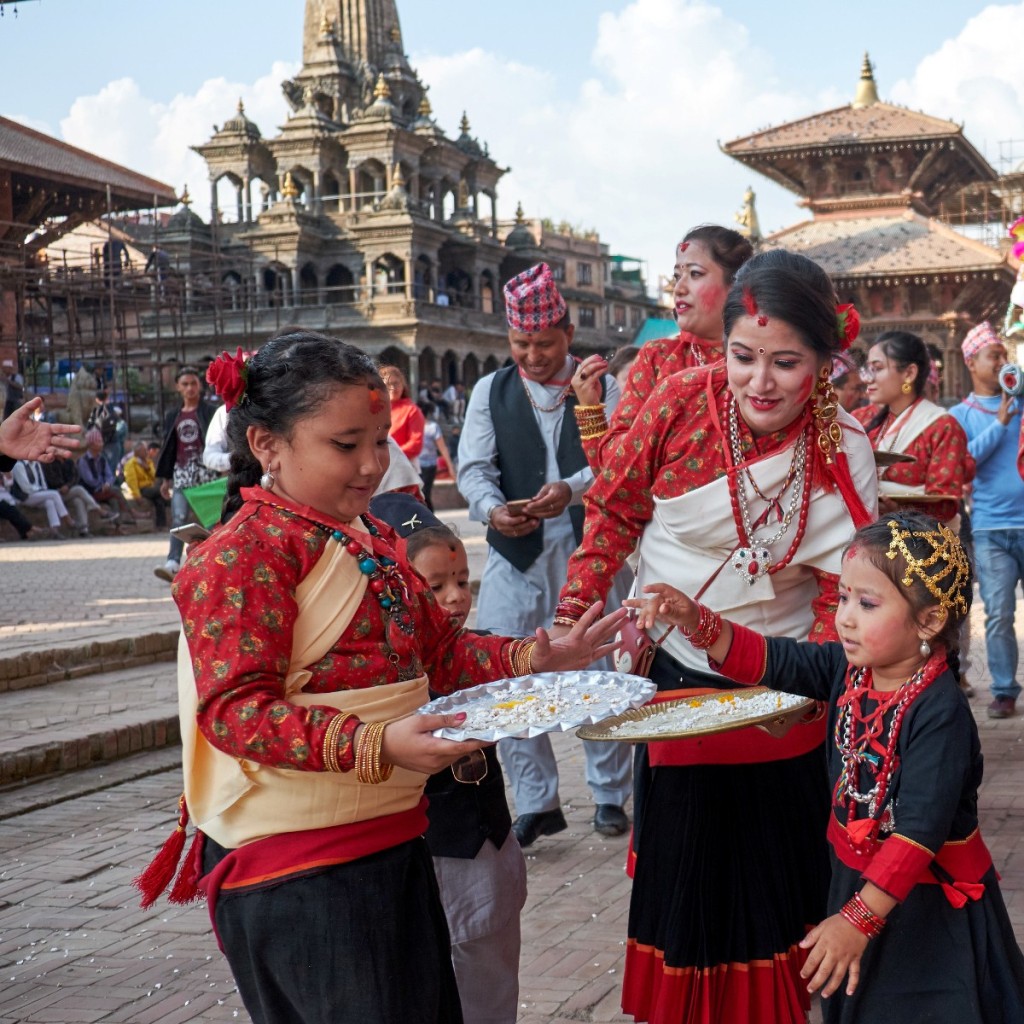
1.Kartik Naach
Kartik Nach is a dance and musical play which is especially performed in the month of Kartik, the seventh month of the Hindu Lunar Calendar and so the name, Kartik Nach. Kartik Nach was initiated by the then king Siddhi Narshing Malla in order to maintain social, cultural and religious harmony among the people of various castes in 16th century. Even after 300 years of establishment, Kartik Nach is still famous and is performed in Patan Durbar Square, Lalitpur. Although the dance form went through a lot of challenges during the course of time, the dance survives till today and is still practiced in Patan Durbar square every year.
Originally the play was performed for 27 days, consisting of 17 stories of Lord Vishnu also known as ‘Narasimha’ of the Hindu mythology. Then the performance had been reduced to five days. However, later in the days of king Shree Niwas Malla, son of Siddhi Narshing Malla, it was extended for more days. Again, in the time of king Yog Narendra Malla, grandson of Siddhi Narshing Malla, it was extended for 15 days. Till 2006 BS, Kartik Nach was performed for 27 days, but later in 2007 BS, it was performed for 2 days. It continued until 2037 BS and then again, from 2038 BS it was performed for eight days. Yet again in 2070 BS, it was performed for 10 days. However, in 2071 BS, it was extended for 12 days. At last, in the year 2075 BS, it was performed for 10 days.
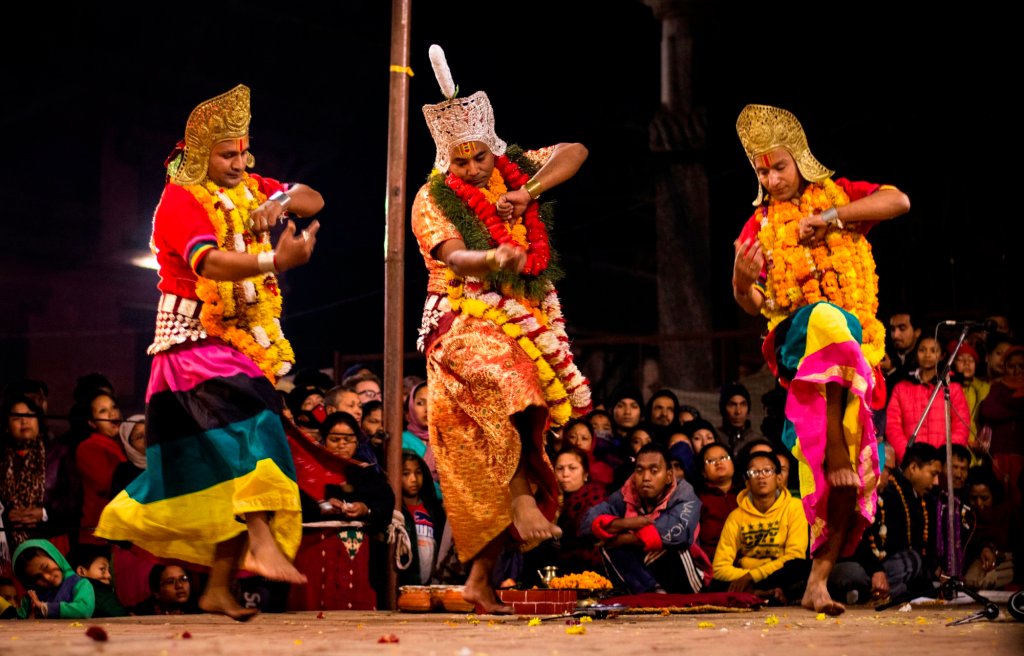
Till 2070 BS, the responsibility to perform Kartik Nach and to preserve this very culture of the Newari community was under “Kartik Naach Prabadhan Samiti”. From the following year, it became the responsibility of the “Kartik Nach Sanrakshan Samiti” (Kartik Dance Preservation Committee) which is located in the premises of the Patan Durbar Square and still prevails under the leadership of Kiran Chitrakar.
Although, Kartik Nach is performed once a year, it’s practice starts from Baisakh, the first month of the Hindu calendar, according to the performers enrolled in that year. The duty to train the new members belong to the current experienced members or veteran members of the group. New members will be trained according to their interest in all fields from dancing, singing, acting. ‘Kartik Nach is three centuries old and yet, the youths are as motivated as the old generation to preserve this culture. It can be considered as the reason for the committee to hold more than 250 members in the committee from the age of 8 to 80,” said Chitrakar. He, also, mentioned that women never participated in the Kartik Nach. All the roles are played by the males in the play. Till today, there is no record of a female participant in the play. The reason for no female participation might be because of the menstrual cycle which girls have to go through every month and they are not allowed to worship gods and goddesses during their periods and also, the play usually starts in the evening and in the past, there was not much security for females as today. But, he believes this trend might be changed in the coming future.
Currently, the committee is running from some donations and funding they get annually from local organizations and the metropolitan city. The committee annually submits a budget plan to the government but they have never received the required money till date and the committee is always forced to manage with the amount they have been provided with. “Last year the committee submitted a proposal requesting for 12 lakhs but were only provided 2 lakhs, which is very disappointing,” said Chitrakar. Chitrakar hopes that in the future government will show more concern about this culture, so, that the future generation can also enjoy it and preserve it.
2. Mataya (Nyaku Jatra) – Festival of Lights in Patan
Mataya is a day-long festival unique to Patan and is always held the day after Gaijatra(festival of cows-one of major festivals of Nepal). Similar to Gaijatra, this festival shows the devotion and love of people for their recently deceased relatives. However, Mataya differs from Gaijatra as devotees go on a pilgrimage-like journey . One can see crowds of people performing sacred rituals, tossing rice grains, flowers and lighting candles. Devotees wear sacking over their near-naked bodies to protect them as they prostrate themselves before each shrine that they visit with the belief that this helps their dead ones rest in peace. Line of devotees on a pilgrimage journey of the occasion of Mataya
Introduction
Mataya is a unique Buddhist festival of Patan to be held in the month of August. This day-long journey around the historical city starts at the dawn, on the third day of the dark fortnight of Shrawan (August). Very few cities in the world compares with Patan (Lalitpur) in the richness of its cultural heritage – a claim that really makes sense, especially when you are talking about something with the unmatched wonder of – Mataya Festival. This word “mata” means ‘lights’ and “ya” festival or also means to a sacred ‘journey’.Another form of interpretation is that Mataya or Matya in Nepal Bhasa i.e. not conquered (by the Maras). Being defeated Mara, the god of desire submits to the Buddha and pay homage to Lord Buddha for confession.
In this event people participate in this festival to worship Buddha and also for accumulating merits for the dead. Devotees process to all the Buddhist shrines inthe city, offering rice grains, flowers and lighting candles. Men and women walkin a line of thousands between these musician groups and do puja at the votive shrines (chaityas) carrying lighted candles and torches.
Historical background:
According to Wright’s chronicle, Lichchavi King Gunakamadeva, (the grandson of King Balarchana Deva) was the first king who instituted the tradition of Mataya Festival together with Sringabheri Jatra. To organize the festival he asked ten localities (tole) of the Patan city. They were
1.Mangal Bajar
2.Chakrabahil
3.Ikhachen
4.Bubahal
5.Haugal
6.Ukubahal
7.Ikhalakhu
8.Kobahal
9.Saugal
10.Nakabahil
Preparation of Mataya Festival:
The preparation for Mataya begins on the first day of Gunla. After mid-night on this day a group of some hundred people with nava bajan (traditional Newari musical ensemble) gather and follow the exact path that they are to follow on the day of Mataya. They don’t finish the whole route on a single go, but gather every night for a few nights and markthe shrines and courtyard with vermilion, husked rice and coins as they pass. This eventis called Bogiwonegu. On the grand day of Mataya, massive number of devotees, sometimes as many as several thousand, gather at the locality that is in charge of the festival for that year.There are ten different localities which take turns to organize the festival by sponsoring instruments, musicians and all the other expenses.
This year’s (2012) Mataya is organized by the Koh-Bahal locality. They gather at the lead locality dawn and start their yatra with a hint of excitement and uncertainty in their cheerful faces; for they must walk all day long often bare-footed and fasting. It is a greatscene to watch people prepare for their procession around the four principal Ashoka stupas spread in and around the four corners of Patan. They must all visit all the 1400 private and local votive shrines scattered in the city on their way.
3.Krishna Janmashtami
Lord Krishna is regarded as the 8th avatar or ‘incarnation’ of Lord Vishnu. Krishna belonged to the Vrishni clan (yadu vansa) of Yadavas from Mathura. He was the eighth son of King Vasudev and Queen Devaki of Mathura. He was born exactly at midnight. His incarnation took place to end the ill doings of his wicked maternal uncle Kansa. He was biological child of Vasudev and Devaki, but he was brought up by Nanda and Yasoda Maiya. Krishna’s childhood is full of fun and love. His youth is romantic and example of love and friendship with Gopis and Gopinies. He was married to Rukmani. His beloved Gopini was Radha. Krishna has very important role in Holy Battle of Mahabharata. He was the Chariot Rider of Arjun. He was the main character who supported Pandavs against Kauravs to win the holy war. His holy advices are known as Bhagwat Gita, where he teaches Arjun about Dharma and Paap (Sin). He did not physically take part in the battle, but he was the heart and soul of Pandavs. The pandavs had never won the war without his help.
He is worshiped with so many names: Krishna, Murari, Hari, Gopal, Shyam, Nanda Lala, Makhan Chor and hundreds of other names. In fact, Krishna said “you just remember me, whatever name; I will be with you, if I know you are calling me”. He is named Krishna because he is Dark. Krishna in Sanskrit is Dark (Black). He is regarded as inventor of Basuri/Murali (flute). He was fond of playing flute. He always had flute in his hand. He played his flute in Brindhaban and Mathura. It is said, the vibration of his music is still floating in the environment of those places.
In Bhagavad Gita Krishna says, “Whenever there is predominance of evil and decline of good doings (religion), I will reincarnate again and again to end the evil and to save the Dharma (good)”. Krishna Jayanti is cel ebration of victory of good and Dharma over devil and bad power. We celebrate this day to to remember that when the pot of sin is filled, there is an end to the devil, God will come to rescue. Krishna Janmasthami reminds us those stories of battle between good and evil and tells us that the good always wins.
Krishna Janmashtami is celebrated all around the world by all Hindu; There is tradition to observe a fasting till midnight. They enchant Slokas from the “Bhagwat Gita” and sing religious songs (Bhajans). The temples of Lord Krishna are decorated and bhajans and kirtan are sung or played. The Krishna Mandir in Patan Durbar Square, Narayanhiti Krishnamandir and other temples of lord Krishna are the centers for festivities in Krishna Janmaasthimi. On Krishna Janmashtami numerous devotees flock to the ancient Krishna temple in old Patan Durbar Square to keep vigil through the glorious night of his birth. As they sit huddled together their bodies rocking in humble obeisance, the women chant the many names of the Lord,’Narayan, Narayan’ and Gopal, Gopal’. Some sing ancient hymns, others clap their hands, while some pray. Crowds of men and women edge their way slowly up narrow steps through the seated devotees to the temple’s dark interior to where the main idol stands. There they offer flowers, coins and food and wait for a glimpse of Krishna Janmastami festival at Krishna Mandir the idol. After the temple priest gives them ‘prasad’ they make their way home.
Beautiful cribs holding a small idol of the “Balgopal” (baby Krishna), the makhan chor, are installed in all Krishna temples. Krishna lila (drama) is performed during this festival.
4.Astamatrika dance
Astamatrika Dance of Eight Mother Goddesses, tutelary deities of Hindus, performed by 13 male Buddhist dancers on nine nights during the Dashain festival. The Dance was introduced by King Sri Nivash Malla (1627–1687 AD). Once he saw in his dream the congregation of Mother Goddesses dancing in his royal court Mul Chowk. He established the Astamatrika Dance and determined, it should be performed every year. The King himself a scholar and tantric, composed the song of various deities also known as Charyagita. The Charya Dance and Charyagita are performed and sung simultaneously. The Charyagita has spiritual significance which can not be fully comprehended by uninitiated people. The musical instruments used in this dance are called “Ponga” and are supposed to be heavenly instruments.
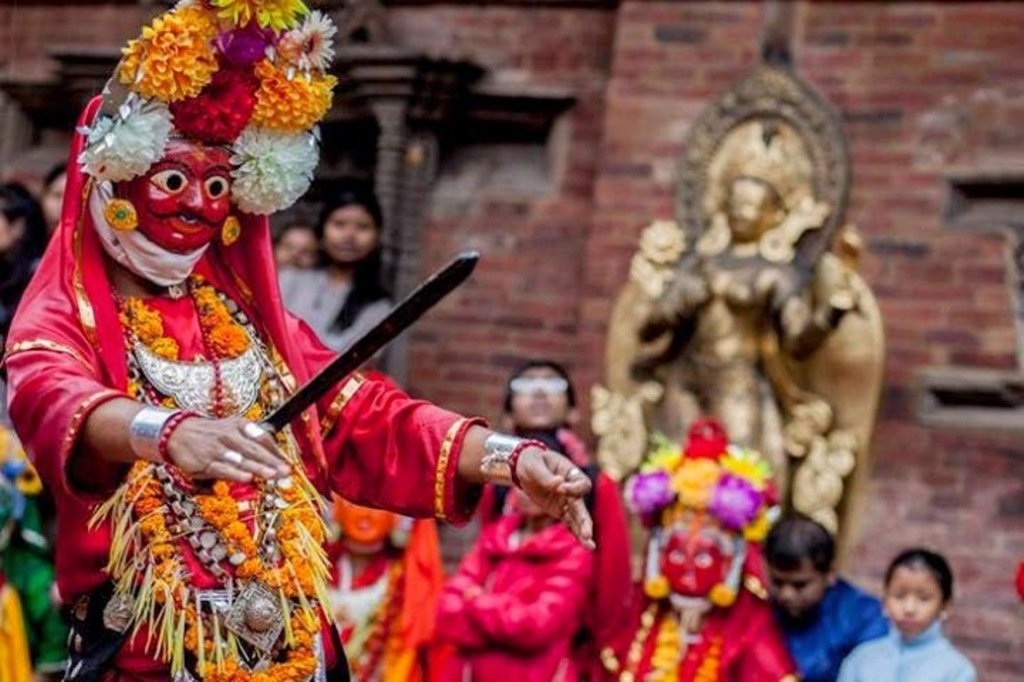
The dance of Astamatrika is for the removal of obstacles in the city caused by unknown evil spirits, ghosts and great fears. Besides, a tantric practitioner worships the Astamatrika for the attainment of great Siddhis for well being, peace, prosperity of the country and the people. The dancers get prepared by going to the temple of Vajrasattva and take Refuge on Buddha, Dharma and Sangha. They purify their body, speech and mind and must refrain from talking impure foods. The rituals should contain cereals and vegetarian items.
Astamatrika Dance is also a ceremony that is ritually marked by a set of masks, which on this occasion, are worn and danced with. These masks have a continual life tone or energy. They are focal points of the Astamatrika Dance ceremonies. In Newar Buddhist Society, the makers of the masks are Hindu Buddhists called the Chitrakars. These artists work within a relatively strict iconography tradition.
5.Bhimsen Rath Jatra
Bhimsen Rath Jatra is celebrated to worship the deity Bhimsen who Newars(historical inhabitants of Patan) worship as a ‘God of Commerce’. Like the Rato Machindranath Jatra, a chariot is prepared for this occasion. However, the chariot is very small in which a wooden statue of Bhimsen is placed. During this festival which happens in front of Bhimsen Mandir in Patan Durbar Square, devotees burn incense sticks and the aura gets so thick that the air can be suffocating. Those who stay till the end of the ceremony and bring back the burning incense sticks to their homes are said to be blessed by god Bhimsen.
A jatra fit for a deity
Much to the joy of revelers’ and devotees alike, the jatra starts as the last of the sun’s rays retire for the night. The starting place is from his humble abode in the Darbar Square, where scores of people have gathered to participate in the festival with wholehearted enthusiasm. It finally begins when, amid the huge cheers from the onlookers, the idol of the deity is placed in the palanquin especially built to lug Bhimsen about town.
The procession is taken through the narrowly ancient streets of Patan, in route that roughly encircles the temple. Throughout the route, people have spilled across the streets where there is much merry-making, which is evident by the gales of laughter mixing with the noise blaring from all direction. The atmosphere is enlivened by the strong aroma of home-made incense. Most of the devotees are burning incense right and left and the aroma hunts the streets numbing every sense, demanding torrents of tear as sacrifice. There is ancient magic afloat in the air, the kind that makes people wish that the merry making time would last forever. All eyes are scanning the horizon, or at least the last galli or the chowk visible, before the buildings closed in on the either side.
The distant music and the cheering is getting louder and some of the people sitting on the sidewalks have started to run their hands around their person, in desperate attempts to find the match to light the incense. For the luckless, there are always the street vendors who have set up their pasals in convenient places. They are selling the ‘best’ and the most aromatic ‘praying aid’ the incense industry has to offer, and at Rs 10 per pack, it’s a bargain. The distant hazel of smoke is getting closer and so is the cheering, you can almost make our part of the incessant cheers. If you listen closely you can almost make out these words: ‘Hail, Lord Bhimsen!’
The sight of the Bhimsen’s palanquin drawn through the streets invokes awe-inspiring reaction. If you could put an image into poetry, that would be it. The palanquin is strewn in the mesh of bamboo sticks, manned by able bodied men who are sweating like anything. In the chariot, the deity is ‘sitting’ in full royal grace, dressed in his Sunday best (if you have to define the dress, nothing gives a clear picture than being dressed in their Sunday best however ironic it may seem, such as in this case). On both sides of the street, people are craning their head for a better view. Some of them are praying hard. Closing their eyes and concentrating till their eye brows bridged their gap, they are busy reciting prayers, wishes and songs of gratitude in an incoherent mumble. Even though praying is one of those businesses that you would like to conduct in solitude, no one is looking any embarrassed than the other guy. They are all here to prostate before their protector.
Most of the crowd comprise of businessmen, calling out to Bhimsen till their throats are soar, burning incense until their eyes have become tomato red. But, do take a glance, notice the unique concoction of people that have poured out in the streets. Not all of them are businessman, in the total sense of the word. And, surely, not all of them are religious for that matter. So, why they are here? Well, like the gods before them, they all love a good show and can tell when one is about to begin. Jatras are, if you dissect the word, after all a form of street theater. There are various rasa floating about, the religious ranga (color) being the most prominent here. Even Shakespeare puts it that the world is a stage and so on and so forth. After all, aren’t we all conducting our life as if it is our primary business? And, a business does require a protector, does it not?
6.Panchadaan -A Big Buddhist Festival
Panchadaan is originated from Buddhism beliefs, Panchadaan literally translates to ‘giving away five’. The five things are wheat, grains, rice grains, salt and fruit which are given to Buddhist priests as offering. Visitors can witness Buddhist traditions and culture as Buddhist antiques are displayed in public and gigantic effigies of Dipankar Buddha are paraded around the town.
Panchadaan is a big Buddhist festival which almost all ? 1-) the Nepalese Buddhists celebrate every year with great enthusiasm. It must be remembered here that the entire Buddhist community in Nepal except those few who belong to the Hinayana sect (yellow-robed) are householders. So when any Buddhist festival takes place in Nepal, it is always the household Buddhists who take the most active part.
It is interesting to note that this festival is celebrated in Kathmandu and Bhadgaon city on the third day of the dark fortnight of Bhadra which generally falls in the middle of August, whereas the Buddhists in Patan, which is said to be the oldest Buddhist city of Nepal, celebrate it only on the eighth day of the bright fortnight of Shrawan. However, the majority of the Buddhists in Nepal seem to follow the Patan-tradition.
One of the main features of this festival is the giving away of alms to the Buddhist beggars. As a very old custom would have it, on this particular day all the Buddhists, rich or poor, go door-to-door in a sizeable group to beg for alms. Such a group of Buddhist beggars is generally regarded as the mission of Lord Buddha himself and treated very well when they are received in the Nepalese homes for the alms-giving ceremony. Giving away of the alms to such Buddhists on this day seems to have been widely recognized by the Nepalese people. There are several Hindus who also give away some foodgrains in charity to the Buddhist beggars on this day. There are many religious trusts devoted to this giving-away ceremony. The Buddhist monasteries are the places where even the non-Buddhist people can be seen giving away the foodgrains to the Buddhist beggars. The Dangatha chapter of Kapidawdan, a very old Buddhist text says that those who give away food and clothes to the saints and sadhus on this day would be blessed with seven great gifts in return viz., health, happiness, longevity, wisdom, wealth, fame and children.
The famous Buddhist text, Kapidawdan, has a lot of interesting stories to tell about the significance of the Panchadaan ceremony. It says how even a monkey who with great feelings and faith gave away a jack fruit in charity to Lord Deepankar (legendary Buddha) was reborn as a human being then and there by dint of his meritorious, deed.
And, another story is about the poverty-stricken woman who despite her untold pain and poverty kept working for several years like a slave from which she saved a plenty of money but spent all this on a very ambitious giving-away-ceremony in honour of Lord Deepankars. The day this auspicious ceremony took place is recorded in the text mentioned above as the Panchadaan Day. This lady locally known as Guita Budhi, even today is well remembered by the people particularly of those in Patan. There is a very old Buddhist monastery at Tyagal Tole in Patan popularly known as Guita Bahee, which interestingly enough seems to have been named after the same lady. There must be some very strong reason for her being so closely associated with the monastery. Deeper study is called for to find out the real fact. Guita Bahee, in Newari means “the nine storeyed monastic building, which according to a Buddhist scripture was built by a king famous in Jatak stories named as Sarvanda. The Jatak says that Lord Deepankar visited Patan several times and stayed at the Guita Bahee monastery, then known as “Prasanna Sheela Mahavihara.” It is said that every time he went there became very happy and so his favourite monastery itself was named as Prasanna Sheela Mahavihara, meaning the monastery for the one who is happy by nature.
This monastery displays some fascinating clothes and jewelry of Guita Budhi lady every year on the full moon day of Shrawan. Even today, Guita Bahee monastery of Patan is considered to be the most important Danshalaa — perfect place for giving away all the best one can afford to the Buddhist saints on the Panchadaan Day.
The number nine in Buddhist culture is a very significant number. It must be remembered here that nine Buddhist Chaityas shrine can still be seen well standing in the courtyard of the aforementioned monastery. It is interesting to note that there is a very old Buddhist tradition in Nepal according to which on the full moon day of the month Shrawan, the Nepalese people are advised to visit the nine different monasteries, changing the nine different dresses on the same day and, of course, to have also the nine different dishes to celebrate the occasions. It must be remembered here that this month of Shrawan according to Nepal Samvat (Era) is the ninth in the series of other months to follow round the year. The Newar people call this month Gunla, which is the most significant month for the entire Buddhist community of Nepal. According_ to the Buddhist tradition this month is the best for all kinds of religious rites and charity. One of the main reasons for this seems to be the seasonal fear. The month of Shrawan is generally considered to be very dangerous because of flood, epidemic disease, and many other havocs which are likely to break out in this very month. To get rid of these possible dangers, the Buddhists seem to have started the practice of symbolically seeking the shelter of Lord Buddha and thus, feel safe and sound.
7.Mha Puja-Worshiping inner self
Mha Puja is an annual ritual performed by the Newar community of Nepal. It is the most important festival in Newar community as it is considered as “New Year” or the ‘”worshipping of the self ” in Newari culture. During Mha puja people are said to be worshiped as god. This ritual is done for the purification and empowerment of the soul as a part of New Year celebration. It is performed on the time of Tihar a day after Laxmi puja and a day before Bhaitika. It is celebrated on the 3rd day of Tihar. As Mah Puja is celebrated only in Newar community, in this day people of other community celebrate Goru puja and GovardhanPuja.
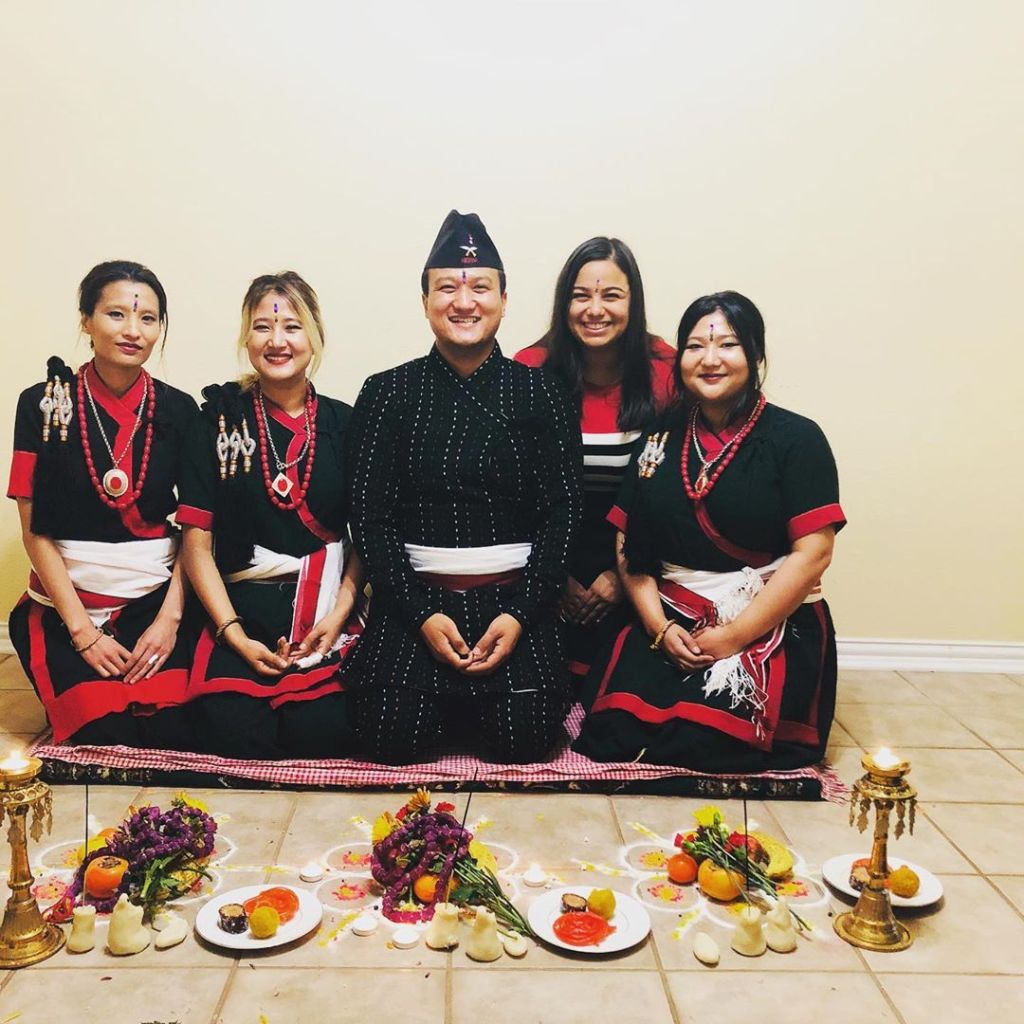
In Newari language ‘Mha’ means our body .So, basically Mha puja is a day when we actually worship our body or inner self .Mha puja is the purification, strengthening and understanding of oneself.
Mha puja carries all the grandeur that a typical Newa festival or ritual possesses. Mha puja is conducted mostly in evening or in the afternoon to make sure that Mha puja of Aagandya (the family goddess) and Mha Puja of goddess Talejubhabani at the three place khwopa (Bhaktapur), Yen (Kathmandu), and Yala (lalitpur) have been conducted by the high Newar priests. These Mha puja ceremonies of the goddesses are not accessible to the general public. It is said that at the time of Newari regime, the king, the priests and some high ranking Newars were able to verbally communicate with the goddesses through tantraism.
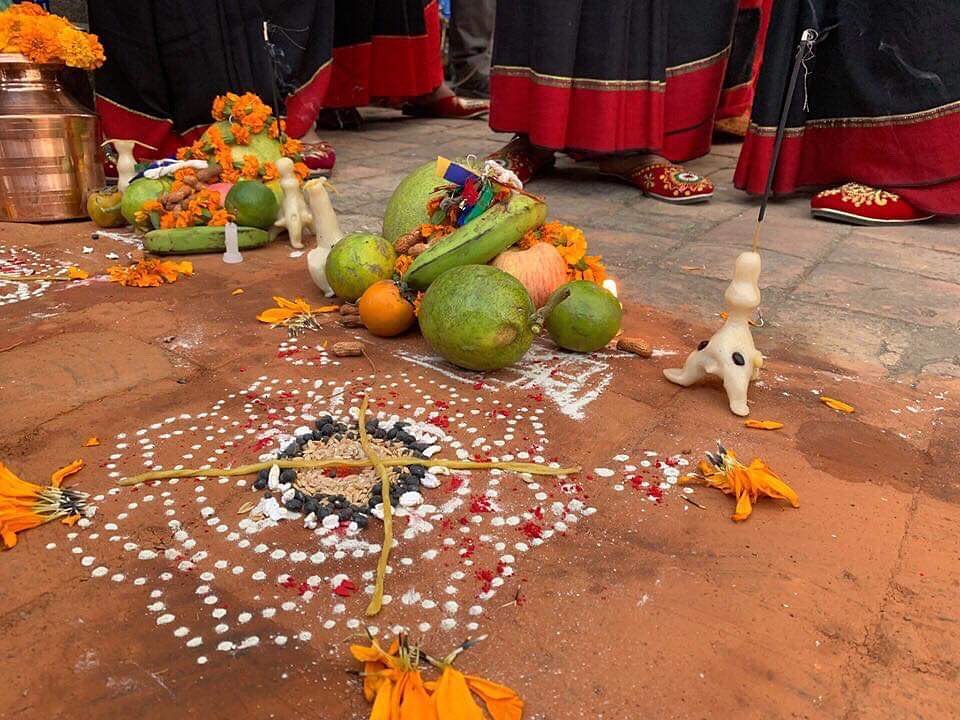
The regular Mha puja found in every Newar household is usually performed in the floor in the dining area .Newars residing outside Nepal miss the this grand event very much and the details seem increasingly interesting. Basic elements of Mha Puja are the same for all Newars. Some procedural details may vary or differ from family to family. Also it is celebrated for the good health and long lives of the soul. The day is also celebrated as a Nepal Sambat or the Newari New Year. The celebrations invoke prosperity and longevity for the worshipper. Mha puja and Nepal Sambat are also celebrated in abroad where Nepali people are settled. The element is also recognized as the symbol of the world .The mandala is symbolized as the world, fruits and sagun as the offering made by the earth. Moreover, the celebration and feasting by the family members with the lights around the mandala help to strengthen the family relationships.
The married daughters are not allowed to perform puja in their material home in some of the Newari culture. Also there are many Newars who celebrate this culture but there are only few Newars who doesn’t celebrate this festival. Hence, there is no other Newari festival is solely devoted to enriching oneself both physically and spiritually. Mha Puja is celebrated with as much vigor as any other important festival. According to Hindu religion, soul or the inner self never dies. There is a belief that in our inner self there is god in us. Also everybody worships his /her own mandala. Also the mandala is lighten up by itaa and red color .Each Mandalas is carefully prepared on the floor by the following a procedure. A set of closely spaced concentric circles are first drawn in each Mandala area by employing a mustard oil soaked cloth piece wrapped around a flower plant steam or a pencil. It may be worth mentioning here that Mha Puja stresses in strong, long lasting, bright, healthy ,fragrant and such other thing with positive connotations and only materials that are considered clean. The circled signify completeness .On the top of the oil rings a beautiful artistic geometrical shape which constitutes the core of the mandala is created. The markings are done in the yellow potaye. On the outside is a large ring enclosing a smaller one with the abhir is spread along the various potaye lines with the respect to the worshipper and at the center of the mandala.
Everybody is concern about the long itaa which is believed that if the itaa is burn for a long time then the person’s life is long live but if the light is burnt fast then the life is short .Also A priest or a eldest female in the family in the home does this rituals and worship the house god to the Yamaraj. Also the lights are lightening up from the house gods to mandala to the Yamaraj. Manda (Mandala) is an essential part of Mha Puja celebration. First the floor (usually tiled or plastered) is purified by sprinkling holy water collected from a sacred stream. Next Mandalas are created on the floor in the front of the row of the seats for the family members and elsewhere. The told number of the mandals exceeds the number of people in the household by three.
While the ceremony set up we place flower as a symbol of new broom, bamboo tray, and water pot as is the house god. At the last as the crow is drawn as a symbol of ever watching Yamaraj, the ambassadors of the death who is always ready to rake sinners to hell.
The Mha Puja is done in a special mandap (decorated by flowers, garlands, sweets, meat, lentil and fruits) for each, by being offered a Shagun (which consists of fried eggs, fish, fruits and local alcohol) by the female family member.
Even today, people are very enthusiastic to welcome the New Year. Every year, the day starts with a rally and the greeting of “NhuDayaBhintuna!” which means “Happy New Year”. Different program and functions are also organized in the Kathmandu Valley every year on this day. Offering of a variety of fruits, nuts and sweets is for a fruitful and resourceful life. The walnut is tough outside but carries tasty nut inside. ‘Tahsi’ fruit has thin skin and provides tasty sweet and sour fruit. Nepal Sambat was founded on October 20, 879 A.D. during the reign of Thakuri King, Raghavadeva. According to a mid-fourteenth-century Sanskrit chronicle an epoch-era was dedicated to Lord Pasupati (Pasupatibhattarakesamvatsarapravartkritah) during his reign. The arrangement of the food on the plate also represents a mandala, with a mound of beaten rice at the center surrounded by portions of eight side dishes. In addition, other food items are served to make a sumptuous feast.
After dinner, the plates and leftover food are left as they are overnight. The floor is swept clean the next day. So, Mha Puja is the most important and auspicious culture of the Newari people’s .It is the finest culture of the Newari. Mha Puja is the most unique festival of Newars as it is done at night and mainly done for the worship of the inner body and soul. It is mainly done at night and at the same time it lies in the Nepal Sambat, New Year of Newar. The arrangement of the food on the plate also represents a mandala, with a mound of beaten rice at the center surrounded by portions of eight side dishes. In addition, other food items are served to make a sumptuous feast.
This has led some historians to surmise that the foundation of the era was due to some religious event connected with the national shrine of Pasupatinath.
8.Samyak Mahadan
Samyak Mahadan, a thousand-year-old Buddhist alms-giving festival was celebrated from 26–27 February on a large open ground in the historic Nepalese city of Patan (now Lalitpur Metropolitan City) in the south-central part of Kathmandu Valley. The main focus of the festival is to honour the buddhas, particularly Dipankara Buddha, who, in a previous life, predicted the enlightenment of Shakyamuni Buddha. According to The Kathmandu Post newspaper, Samyak Mahadan was first celebrated in Kathmandu in 1015 CE (135 in the Nepalese lunar calendar) and is observed once every 12 years in Kathmandu, every five years in Patan, and every year in Bhaktapur, a city in east corner of Kathmandu Valley. This year, the celebrations in Patan marked its 472nd anniversary, with more than a million people reportedly taking part.
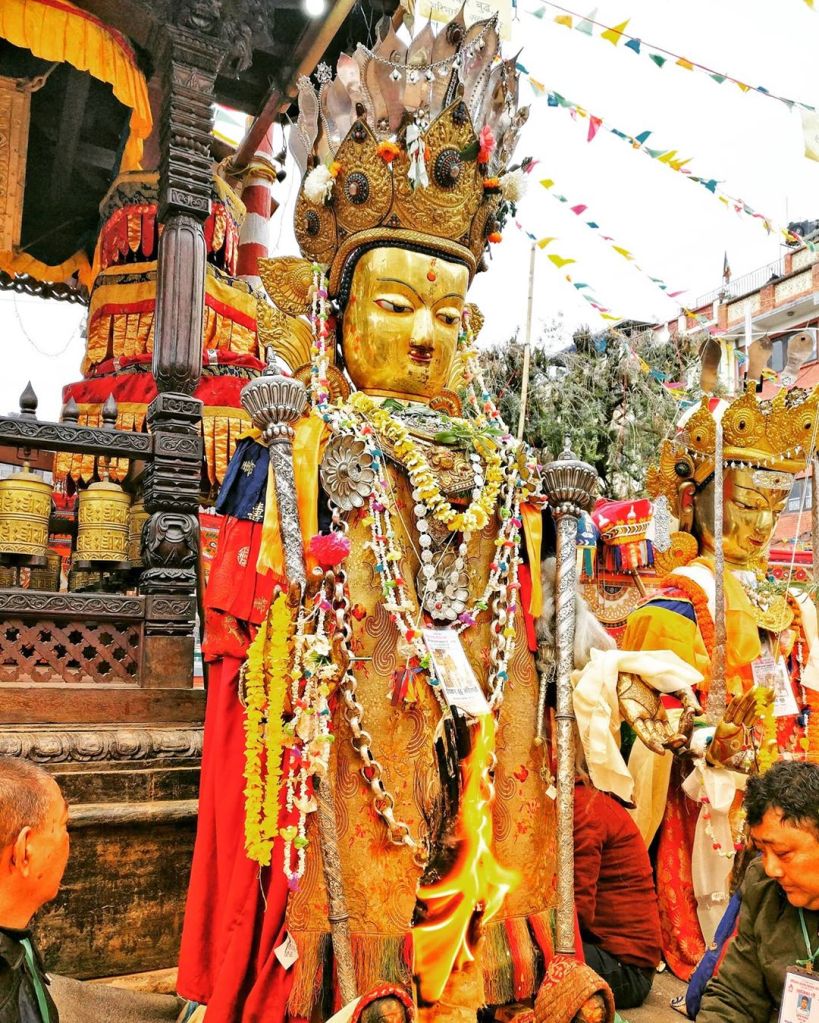
The festival brings together a wide cross-section of the Newar community, including lamas, musicians, artists, and farmers. During the celebrations, the city reverberates with the chants of lamas and Buddhist religious performances. The event showcases a variety of Newer Buddhist elements, with hundreds of images of Dipankar Buddha, and other buddhas and bodhisattvas, including Avalokitesvara and Arya Tara, and gifts of different types of food for the deities of the Buddhist cosmos.
“The festival is quite important for Buddhist Newars, as it has become a way of practising daan (an act of giving and sharing) dharma. A festival that also has, over the years, nurtured our faith,” said local resident Sabita Dhakwa. “We were lucky as we took an inside route, so we didn’t have to wait in the line for long. But many people had already arrived before us, fearing that the queue would have them standing for hours.”
The Samyak Mahadan festival in Patan is organised by Hiranya Varna Mahavihar, informally known as the Golden Temple, with funding from the Ittilihane Samyak Mahadan Ayojak Samittee, a unit of the Mahavihar. They form an organising team with a diverse network of people, from Chitrakars to Rajkarnikars, for the celebration. “The Rajkarnikars make matha rotis for the festival, and the Chitrakars are given works related to decoration and paintings of deities,” said Hira Ratna Shakya, a resident of Nagbahal, in the city of Lalitpur. (The Kathmandu Post) “It takes around two to three million [rupees; US$26,000] to organise the festival for the organising team,” said Pushpa Raj Bajracharya, one of the festival oranizers, who also served as a priest in the Mahavihar for a month this year.
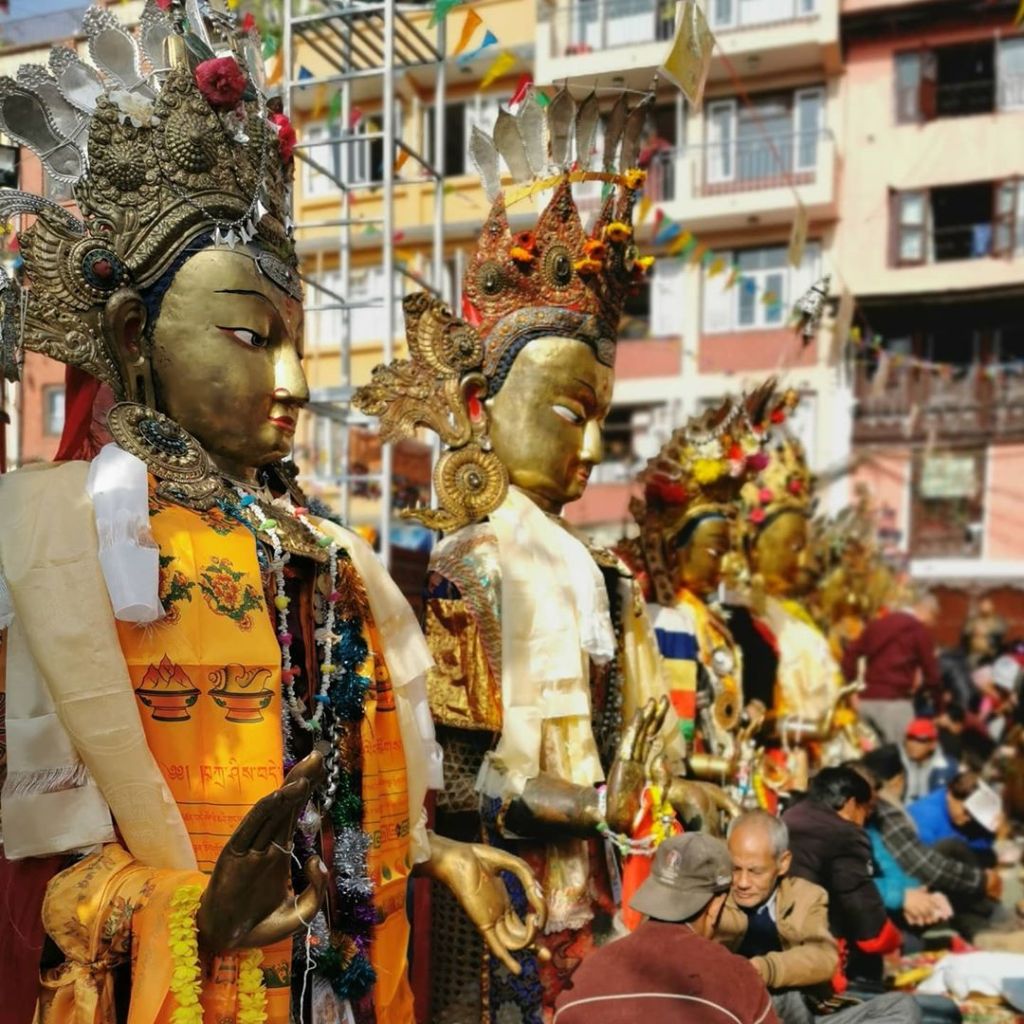
Bajrachariya explained the preparations for Samyak Mahadan: “Every month the Vihar appoints two priests. One a young boy who should have just finished his chudakarma ceremony, a coming-of-age festival, and the other an adult who becomes the assistant priest for the boy, bafacha.” Bajrachariya further said that 12 assistant priests together coroodinated various groups of participants, and organised a sangha bhoja (feast) in Nagbahal at the end of the lunar calendar.
According to The Kathmandu Post, Samyak Mahadan used to be celebrated annually until 1805, when, due to a lack of resources, social group Samyak Guthis began organizing the festival once every five years. Bikash Ratna Dhakwa, a co-organiser of the festival, recounted the story behind the origins of Samyak Mahadan: “It is believed that during the time of king Bhaskar Dev, a Thakuri ruler, one of his sons, Bharibharo, was a poor king. He was poor because he was generous to his people. But to hide the fact that he was poor from his people and his wife, he used to fill his storehouse with cow dung and lock it, telling people he had treasures inside. Then, one day, because of his faith and kindness, the dung turned into gold. Amazed with the incident, Bharibharo organised the Samyak festival to share his wealth with the people. It is believed that we have been celebrating the festival since then.”


This is my favorite place
LikeLiked by 1 person